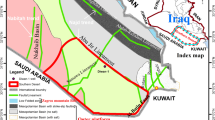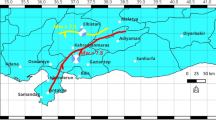Abstract
Discontinuities formed by different geological processes strongly affect the inhomogeneity of a rock mass. Demarcation of statistically homogeneous regions is useful to speculate the tectonic evolution history. Therefore, a new method is introduced to divide the homogeneous structural domains based on multiple discontinuity characteristics. The new method is divided into three steps. Firstly, the 34-patch network on the lower-hemisphere Schmidt projection and the correlation coefficient are adopted to quantify the similarity of discontinuity orientation. Secondly, the Wald–Wolfowitz runs test is utilized to identify the similarity for trace length and trace type. Thirdly, the structural domains are comprehensively identified based on the similarity of discontinuity orientation, trace length and trace type. The comprehensive method is subsequently adopted to divide the structural domains within the Songta right abutment rock mass. The results illustrate that the rock mass around PD222 and PD234 belongs to the same structural domain D1 and the rock mass around PD224 and PD236 belongs to the other structural domain D2. The D2 located at the high elevation suffers longer and stronger unloading effect of the river valley, which is more likely to form the long discontinuities. However, the D1 located at the low elevation develops mainly the short discontinuities. Hence, it is reasonable and consistent with geological development background that the abutment rock mass is divided into two structural regions along the vertical direction using the new method.











Similar content being viewed by others
References
Alzayer Y, Eichhubl P, Laubach SE (2015) Non-linear growth kinematics of opening-mode fractures. J Struct Geol 74:31–44
Chen JP, Xiao SF, Wang Q (1995) Computer simulation theory of 3D random discontinuities network. Northeast Normal University Press, Changchun
Cohen J (1988) Statistical power analysis for the behavioral sciences, 2nd edn. Lawrence Erlbaum associates, New Jersey
Escuder Viruete J, Carbonell R, Jurado MJ, Martí D, Pérez-Estaún A (2001) Two dimensional geostatistical modeling and prediction of the fracture system in the Albala Granitic Pluton, SW Iberian Massif, Spain. J Struct Geol 23:2011–2023
Fan LM, Huang RQ, Ding XM (2003) Analysis on structural homogeneity of rock mass based on discontinuity density. Chin J Rock Mech Eng 22(7):1132–1136
Hammah RE, Curran JH (1998) Fuzzy cluster algorithm for the automatic identification of joint sets. Int J Rock Mech Min Sci 35(7):889–905
Johnson RA, Bhattacharyya GK (1996) Statistics: principles and methods. Wiley, New York
Khair HA, Cooke D, Hand M (2015) Paleo stress contribution to fault and natural fracture distribution in the Cooper Basin. J Struct Geol 79:31–41
Kulatilake PHSW, Wu TH (1984) Estimation of mean trace length of discontinuities. Rock Mech Rock Eng 17(4):215–232
Kulatilake PHSW, Chen JP, Teng J, Xiao SF, Pan G (1996) Discontinuity geometry characterization in a tunnel close to the proposed permanent shiplock area of the Three Gorges dam site in China. Int J Rock Mech Min Sci Geomech Abstr 33(3):255–277
Kulatilake PHSW, Fiedler R, Panda BB (1997) Box fractal dimension as a measure of statistical homogeneity of jointed rock masses. Eng Geol 48:217–229
Kulatilake PHSW, Wang LQ, Tang HM, Liang Y (2011) Evaluation of rock slope stability for Yujian River dam site by kinematic and block theory analyses. Comput Geotech 38(6):846–860
Lancaster HO (1969) The Chi-squared distribution. Wiley, New York, p 175
Li M, Li GJ, Zhang W, Liu HM, Wang JL, Yang J (2012) Application of Chi-square method in statistical homogeneity zoning of fractured rock mass in Longmen Peak. Changbai Mountain. J Jilin Univ 42(2):449–454
Li XJ, Zuo YL, Zhuang XY, Zhu HH (2014) Estimation of fracture trace length distributions using probability weighted moments and L-moments. Eng Geol 168:69–85
Mahtab MA, Yegulalp TM (1984) A similarity test for grouping orientation data in rock mechanics. In: Proceedings of the 25th US Symposium on Rock Mechanics. New York, pp 495–502
Martin MW, Tannant DD (2004) A technique for identifying structural domain boundaries at the EKATI diamond mine. Eng Geol 74:247–264
Miller SM (1983) A statistical method to evaluate homogeneity of structural populations. Math Geol 15(2):317–328
Piteau DR, Russell L (1971) Cumulative sums technique: a new approach to analyzing joints in rock. In: Proceedings of the 13th US Symposium on Rock Mechanics. Urbana, pp 1–29
Priest SD (1993) Fracture Analysis for Rock Engineering. Chapman & Hall, London
Sharp WE (2006) Application of the multivariate runs test to compositional data. Math Geol 38(8):1017–1025
Song JJ, Lee CI (2001) Estimation of joint length distribution using window sampling. Int J Rock Mech Min Sci 38(4):519–528
Song SY, Wang Q, Chen JP, Li YY (2015) A method of identify structural homogeneity of rock mass bad on fracture spacing. J Northeast Univ 36(8):1188–1192
Wald A, Wolfowitz J (1940) On a test whether two samples are from the same population. Ann Math Stat 11:147–162
Wang H, Latham JP, Poole AB (1991) Predictions of block size distribution for quarrying. Q J Eng Geol 24:91–99
Whitaker AE, Engelder T (2005) Characterizing stress fields in the upper crust using joint orientation distributions. J Struct Geol 27:1778–1787
Ye JH, Zhang Y, Sun JZ, Wu FQ (2012) Correction of the probabilistic density function of discontinuities spacing considering the statistical error based on negative exponential distribution. J Struct Geol 40:17–28
Acknowledgements
This work was supported by the State Key Program of National Natural Science of China (grant no. 41330636). The authors are very grateful to Hsin Chow for improving the language of this paper.
Author information
Authors and Affiliations
Corresponding author
Rights and permissions
About this article
Cite this article
Song, S., Sun, F., Zhang, W. et al. Identification of structural domains by considering multiple discontinuity characteristics: a case study of the Songta Dam. Bull Eng Geol Environ 77, 1589–1598 (2018). https://doi.org/10.1007/s10064-017-1024-5
Received:
Accepted:
Published:
Issue Date:
DOI: https://doi.org/10.1007/s10064-017-1024-5




